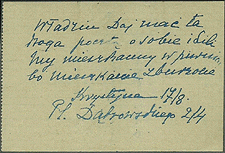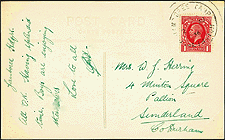
Much has been written about the centenary of the start of the 1st World War, and in many countries,
museums have displays about this event. It is also now 70 years since the Warsaw Uprising which commenced
on 1st August 1944, and was a struggle by the Polish Home Army to liberate Warsaw from German
occupation. The Uprising was part of a nationwide rebellion, and was intended to last for only a few days until
the Soviet Army reached the city. The Soviet advance stopped short of entering Warsaw, as Stalin disliked the
Poles and wanted the city to fall to the Germans. With the city in ruins, resistance against the German forces
continued for 63 days until the Polish surrendered on 3rd October.
The Polish Scout movement was very active underground during the German occupation and being very

 well organized, undertook with
great efficiency, the difficult
task of establishing military
communication channels. The
Scout authorities also realised
the essential need for the civilian
population to communicate with
their families in other parts of
the City, so the Scout Field Post
was established. The first postal
service was set up by a group of
Scouts in Warsaw Central-South on the 2nd of August 1944, and operated a
limited delivery only within that district. On the 4th of August, the Scout
Headquarters decided to organize a full postal service for all parts of
Warsaw. In addition, seven more sub-post offices were opened and as many
as 40 post-boxes were placed in different locations throughout the City. Due
to the isolation of some of the Polish held parts of Warsaw, the only available means of communication was
through the sewers under the streets. During the first month of the uprising, the Scout Movement exclusively
ran the Field Post, with the head sorting office mainly employing Girl Guides. The daily intake of between
3,000 to 6,000 letters was routinely sorted and on a peak day of 13th August, the intake reached about 10,000
letters! The illustrated item (without the Scout circular cachet but with Censor mark No 15) and the reverse
with a message, was recently sold by Gartner Auctions in Germany and made €780 (£650, US$ 1040).
well organized, undertook with
great efficiency, the difficult
task of establishing military
communication channels. The
Scout authorities also realised
the essential need for the civilian
population to communicate with
their families in other parts of
the City, so the Scout Field Post
was established. The first postal
service was set up by a group of
Scouts in Warsaw Central-South on the 2nd of August 1944, and operated a
limited delivery only within that district. On the 4th of August, the Scout
Headquarters decided to organize a full postal service for all parts of
Warsaw. In addition, seven more sub-post offices were opened and as many
as 40 post-boxes were placed in different locations throughout the City. Due
to the isolation of some of the Polish held parts of Warsaw, the only available means of communication was
through the sewers under the streets. During the first month of the uprising, the Scout Movement exclusively
ran the Field Post, with the head sorting office mainly employing Girl Guides. The daily intake of between
3,000 to 6,000 letters was routinely sorted and on a peak day of 13th August, the intake reached about 10,000
letters! The illustrated item (without the Scout circular cachet but with Censor mark No 15) and the reverse
with a message, was recently sold by Gartner Auctions in Germany and made €780 (£650, US$ 1040).
I missed the Cavendish sale held in the UK in June when two examples of the very scarce 1936 Darlington

 Jamboree cancel were
offered in auction. Both
a postcard and the
extremely rare cover
(of which only one
other is known) were
sold. I understand from
the auctioneers that
both items were purchased by two
different private buyers. It was noted in the catalogue that a
similar postcard was sold by them in December 2000 and sold for
£1265 including buyers premium.
Jamboree cancel were
offered in auction. Both
a postcard and the
extremely rare cover
(of which only one
other is known) were
sold. I understand from
the auctioneers that
both items were purchased by two
different private buyers. It was noted in the catalogue that a
similar postcard was sold by them in December 2000 and sold for
£1265 including buyers premium.
|



